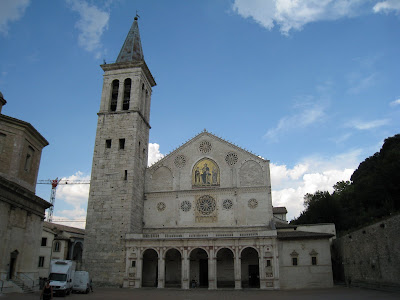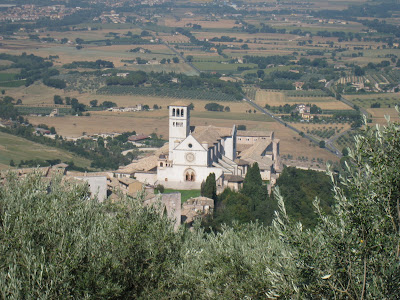




 Detail of the Coronation of the Virgin
Detail of the Coronation of the Virgin Altar in one of the side chapels with a frescoed front depicting Christ as the Vir Dolorum (Man of Sorrows)
Altar in one of the side chapels with a frescoed front depicting Christ as the Vir Dolorum (Man of Sorrows)







 Detail of the Coronation of the Virgin
Detail of the Coronation of the Virgin Altar in one of the side chapels with a frescoed front depicting Christ as the Vir Dolorum (Man of Sorrows)
Altar in one of the side chapels with a frescoed front depicting Christ as the Vir Dolorum (Man of Sorrows)



 The Duomo has a very pretty exterior with an intricately carved door and pretty rose window, below which are three carved figures who appear to be holding up the church. The inside is plain and holds in the font in which St. Francis, St. Clare, and the Holy Roman Emperor Frederick II were baptized.
The Duomo has a very pretty exterior with an intricately carved door and pretty rose window, below which are three carved figures who appear to be holding up the church. The inside is plain and holds in the font in which St. Francis, St. Clare, and the Holy Roman Emperor Frederick II were baptized.  Cathedral of San Rufino
Cathedral of San RufinoIt was obvious that today was going to be another hot day, so I decided to make the trek up to the Rocca Maggiore, a medieval fortress which overlooks Assisi and the valley below. The walk took about half an hour, almost all uphill, though nothing too steep and the views were well worth the climb.
 Rocca Maggiore from the Cathedral
Rocca Maggiore from the Cathedral Street which follows the outline of the Roman amphitheatre
Street which follows the outline of the Roman amphitheatre

 The Basilica from above
The Basilica from above



 The walk back down to Assisi was all downhill, so within ten minutes, I found myself back in town at the Basilica of Santa Chiara (St. Clare), one of Francis’ followers who founded the Poor Clares, the female branch of the Franciscans. Clare’s church is basically a miniature copy of the Francis’ basilica across town, with the addition of buttresses along the walls of the nave to prevent the collapse of the building due to a poor foundation. The interior of the church has remained mostly unadorned, in contrast to San Francesco. What I found most startling is that Clare’s body is on display in the crypt below, laid out in a glass coffin for all to see. Now, I understand the whole saint/relic thing, and can appreciate it even if I don’t agree with it. But really, an entire body?
The walk back down to Assisi was all downhill, so within ten minutes, I found myself back in town at the Basilica of Santa Chiara (St. Clare), one of Francis’ followers who founded the Poor Clares, the female branch of the Franciscans. Clare’s church is basically a miniature copy of the Francis’ basilica across town, with the addition of buttresses along the walls of the nave to prevent the collapse of the building due to a poor foundation. The interior of the church has remained mostly unadorned, in contrast to San Francesco. What I found most startling is that Clare’s body is on display in the crypt below, laid out in a glass coffin for all to see. Now, I understand the whole saint/relic thing, and can appreciate it even if I don’t agree with it. But really, an entire body? The Church of St. Clare
The Church of St. Clare Buttresses supporting the church
Buttresses supporting the churchAfter that semi-traumatizing event, I came back to the hotel for a few hours since everything shuts at mid-day to avoid the heat. Later in the afternoon, I visited the Pinacoteca, which has some very nice medieval paintings, including two crucifixion scenes, both from the Confraternity of Santa Maria del Vescovato, about which I know absolutely nothing, but hope to find out more.
Crucifixion from Santa Maria del Vescovato
Fragment of a fresco depicting the Crucifixion, also from S. Maria del Vescovato
I spent the rest of the afternoon back at the Basilica of San Francesco taking in the frescoes again. In the Upper Basilica, each of the frescoed scenes is divided by painted pillars and molding, done with perspective in mind so there’s a tromp l’oeil effect and it looks like they’re three-dimensional instead of flat on a wall. There’s also a set of beautiful wooden choir stalls which also utilize tromp l’oeil, this time with wood so that the backs of the stalls appear to have doors or shelves for books. As beautiful as the church is, though, I can’t help but think that St. Francis would be appalled at the opulence spilled out in his name.

 Gelato count: 6
Gelato count: 6
 The iconic Basilica
The iconic Basilica

One of the many pretty houses in Assisi

The Pilgrim's Oratory


The way into town from the Basilica - the convent where I stayed is the multi-story building with brown shutters to the far left.

The Upper and Lower Basilicas
 The view as you approach the church
The view as you approach the church



 Gelato count: 5
Gelato count: 5